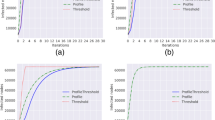Abstract
We introduce a diffusion of innovation model based on a network threshold approach. Realistic network and threshold data were gathered regarding the diffusion of new software tools within part of a large organization. Novel model features are a second threshold for innovation rejection and a memory that allows actors to take trends into account. Computer simulations produce expected outcomes, such as the S-shaped diffusion curve, but also diffusion breakdown and oscillations. We define and compute the quality of change agent targets in terms of the impact targeted actors have on the diffusion process. Our simulations reveal considerable variance in the quality of actors as change agent targets. Certain actors can be singled out as especially important to the diffusion process. Small changes in the distribution of thresholds and changes in some parameters, such as the sensitivity for trends, lead to significant changes in the target quality measure. To illustrate these interdependencies we outline how the impact of an actor targeted by a change agent spreads through the network. We thus can explain why a good change agent target does not necessarily need to be an opinion leader. Simulations comparing the effectiveness of randomly selected targets versus a group of good change agent targets indicate that the selection of good targets can accelerate innovation diffusion.
Similar content being viewed by others
References
Abrahamson, E. and L. Rosenkopf (1997), “Social Network Effects on the Extent of Innovation Diffusion: A Computer Simulation,” Organization Science, 8(3), 289–309.
Bandura, A. (1986), Social Foundations of Thought and Action, Prentice-Hall, Engelwood Cliffs, NJ.
Baron, J. (2000), Thinking and Deciding, 3rd ed. Cambridge University Press, New York.
Carley, K. (1990), “Group Stability: A Socio-Cognitive Approach,” in E. Lawler, B. Markovsky, C. Ridgeway and H. Walker (Eds.) Advances in Group Processes: Theory and Research. Vol. VII, JAI Press, Greenwhich, CN, pp. 1–44.
K. Carley (1991), A Theory of Group Stability. American Sociological Review, Vol. 56.
Carley, K. (1999), “On the Evolution of Social and Organizational Networks,” in S. Andrews and D. Knoke (Eds.) Vol. 16 Special Issue of Research in the Sociology of Organizations, on Networks in and Around Organizations. JAI Press, Inc. Stamford, CT, pp. 3–30.
Farell, J. and G. Saloner (1985), “Standardization, Compatibility and Innovation,” Rand Journal of Economics, 16, 70–83.
Granovetter, M.S. (1978), “Threshold Models of Collective Behavior,” Journal of Sociology, 83(6), 1420–1443.
Krackhardt, D. (1997), “Organizational Viscosity and the Diffusion of Controversial Innovations,” Journal of Mathematical Sociology, 22(2), 177–199.
Mahajan, V. and R.A. Peterson (1985), “Models For Innovation Diffusion,” Sage University Paper Series on Quantiative Applications in the Social Sciences, 07-048, Sage, Newbury Park, CA.
Mark, N. (1996), “Beyond Individual Differences: Social Differentiation From First Principles,” Working Paper, Department of Sociology, University of Arizona.
Stanovich, K.E. (1999), Who is Rational? Studies of Individual Differences in Reasoning. Erlbaum, Mahweh, NJ.
Strang, D. (1996), “Inducing a Network Influence Structure from Multiple Diffusion Processes,” Paper presented at Annu. Eet. Of Am. Sociol. Assoc., New York.
Strang, D. and S.A. Soule (1998), “Diffusion in Organizations and Social Movements: From Hybrid Corn to Poison Pills,” Annual Review of Sociology, Palo Alto.
Rocco, E., T.A. Finholt, E.C. Hofer and J.D. Herbsleb (2001), “Out of Sight, Short of Trust,” Presentation at the Founding Conference of the European Academy of Management. Barcelona, Spain.
Rode, D. (1997) “Cultural Heterogeneity and the Stability of Groups with Imperfect Information Transmission,” CASOS 1998 Working Papers, Carnegie Mellon University.
Rogers E.M. (1995), Diffusion of Innovations, 4th ed. Free Press, NewYork.
Valente, T.W. (1995), Network Models of the Diffusion of Innovations, Hampton Press, Cresskill, NJ.
Valente, T.W. (1996), “Social Network Thresholds in the Diffusion of Innovation,” Social Networks, 18, 69–89.
Valente, T.W. and R.L. Davis (1999), “Accelerating the Diffusion of Innovations Using Opinion Leaders,” The Annals of the American Academy, 566, 55–67.
Weimann, G. (1994), The Influentials: People Who Influence People, State University of New York Press, Albany.
Author information
Authors and Affiliations
Rights and permissions
About this article
Cite this article
Maienhofer, D., Finholt, T. Finding Optimal Targets for Change Agents: A Computer Simulation of Innovation Diffusion. Computational & Mathematical Organization Theory 8, 259–280 (2002). https://doi.org/10.1023/A:1025464501110
Issue Date:
DOI: https://doi.org/10.1023/A:1025464501110




